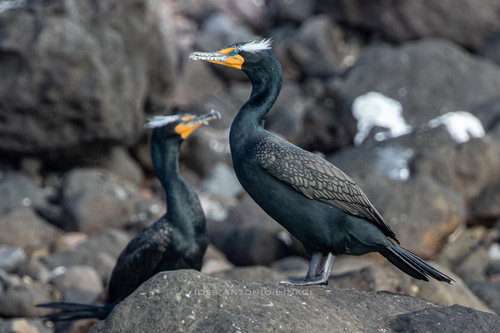
Double-crested Cormorant
The Double-crested Cormorant (Nannopterum auritum) is a widespread North American waterbird known for its diving prowess and distinctive appearance. These birds are skilled fishers, often seen perched on rocks or docks with their wings outstretched to dry. They play a vital role in aquatic ecosystems, acting as both predator and prey. While sometimes perceived as a nuisance by fisheries, they are a natural part of the food web. Their name refers to the small, curly tufts of feathers that appear on the heads of adults during breeding season, though these are often not prominent.
70-90 cm
Length
114-123 cm
Wingspan
Least Concern
Conservation Status
Distribution
Found throughout North America, from Alaska and Canada to Mexico and the Caribbean. They are found along coastlines, rivers, and lakes. Some populations are migratory, moving south in winter, while others are resident year-round.
Lifespan
Average lifespan in the wild is around 6 years, but some individuals have been known to live over 17 years.
Double-crested Cormorant's Habitat
Habitat Types
Coastal marine environments, Estuaries, Freshwater lakes, Rivers, Reservoirs
Climate Zones
Temperate, Subtropical, Tropical
Adaptations
Double-crested Cormorants have specialized features, like totipalmate feet (all four toes webbed), which are excellent for underwater propulsion. Their feathers are less waterproof than those of many other waterbirds, allowing them to dive more efficiently, but requiring them to spend time drying their wings.
Variations
Several subspecies are recognized, differing slightly in size and plumage details. These include *N. a. auritum*, *N. a. albociliatum*, *N. a. floridanum*, *N. a. cincinatum*, and *N. a. heuretum*. These subspecies are primarily distinguished by geographic location and subtle differences.
Appearance
Breeding Plumage
Adult breeding plumage is mostly black with a greenish-blue sheen. They develop the namesake double crest of feathers (white or black depending on subspecies and location). Non-breeding adults lack the crests and have duller plumage. Juveniles are brownish-gray.
Seasonal Feather Changes
The most significant seasonal variation is the presence or absence of the crests during the breeding season.
Sex Based Plumage Differences
Minimal; males and females have similar plumage.
Notable Features
Hooked bill for catching fish, Bright orange-yellow throat pouch (gular skin), Totipalmate feet (all four toes webbed), Small, curly crests on the head during breeding season (often inconspicuous)
Diet and Feeding
Primary Foods
Small fish, Crustaceans, Amphibians
Foraging Behavior
Double-crested Cormorants primarily hunt by diving from the surface and pursuing prey underwater. They use their feet for propulsion and their hooked bill to capture fish. They often forage in groups, sometimes cooperatively driving fish into shallower water.
Specializations
Their hooked bill and strong swimming ability are key adaptations for their fish-based diet. Their less-waterproof feathers reduce buoyancy, aiding in diving.
Seasonal Diet Variations
Diet may vary slightly depending on the availability of prey in different seasons and locations. For example, they may consume more crustaceans when fish are less abundant.
Behavior
Social Structure
Highly social birds, often found in large flocks, especially during breeding season when they form colonies. They also roost and forage together outside of the breeding season.
Communication
Guttural croaks and grunts, Visual displays (e.g., wing-waving, head-bobbing)
Migration
Many populations are migratory, traveling south for the winter. Migration routes and timing vary depending on the breeding location. Some populations are resident year-round.
Territorial or Group Behaviors
During breeding season, they defend small territories around their nests. Outside of breeding, they are generally non-territorial and form large communal roosts.
Conservation
Threats
Habitat loss and degradation, Pollution (e.g., oil spills, pesticides), Entanglement in fishing gear, Human disturbance at breeding colonies, Persecution by humans (due to perceived competition with fisheries)
Protection Programs
Migratory Bird Treaty Act (in the US), Various state and provincial wildlife regulations
Local National Laws
Protected under the Migratory Bird Treaty Act in the United States and similar legislation in Canada and Mexico.
Population Trend
Increasing
Population Estimates
The global population is estimated to be in the millions, and has been increasing in recent decades after recovering from declines in the mid-20th century due to pesticide use (DDT).
Interesting Facts
They often fly in V-formations, similar to geese.
This formation reduces wind resistance and conserves energy during flight.
They can dive to depths of up to 25 feet (7.6 meters) or more.
This allows them to access a wide range of prey in different aquatic environments.
Their bones are denser than those of many other birds.
This reduced buoyancy helps them dive and stay underwater.
After fishing, they can be observed perching with their wings spread open.
This behavior helps them to dry their feathers, as the feathers are not as waterproof compared to other aquatic birds.
Faqs about Double-crested Cormorant
Why do cormorants stand with their wings spread?
They spread their wings to dry their feathers, which are less waterproof than those of many other waterbirds. This helps them regulate their body temperature and improve their flying efficiency.
Are Double-crested Cormorants endangered?
No, they are classified as 'Least Concern' by the IUCN. Their populations have recovered significantly since the mid-20th century.
Do cormorants harm fish populations?
While they do eat fish, their impact on fish populations is complex and often localized. In some cases, they may compete with fisheries, but they are also a natural part of the ecosystem.
What is the difference between a cormorant and a shag?
The terms "cormorant" and "shag" are sometimes used interchangeably, and there isn't a strict scientific distinction in all regions. However, in some areas, "shag" refers to cormorant species with crests during the breeding season, and often those inhabiting marine environments. The Double-crested Cormorant, despite its name, may not always show prominent crests.
Copyright @ Nature Style Limited. All Rights Reserved.
 English
English